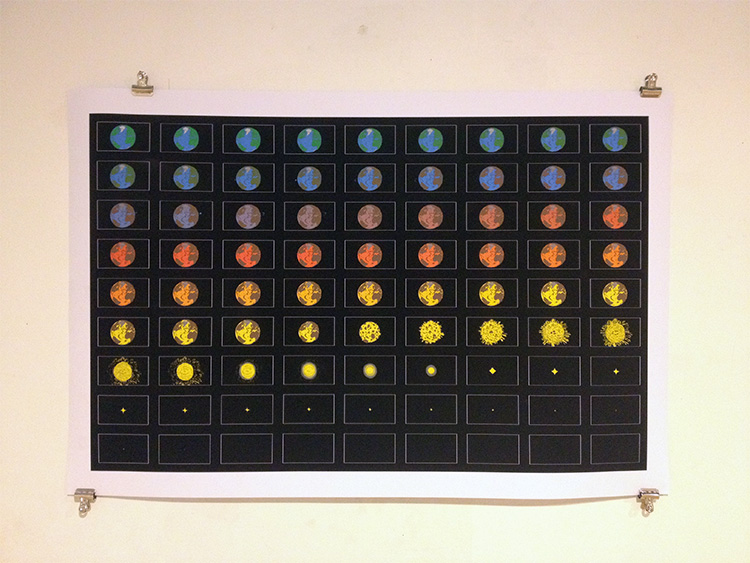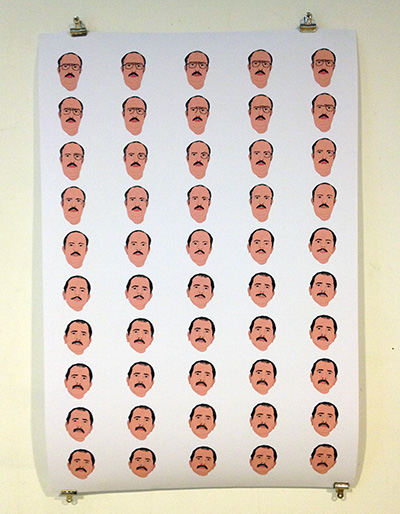Archive for the ‘art installation’ Category
audiophile at RedLine’s “Press Play” Exhibition

audiophile (2001) The software presents remixes of the sounds of the city, from Managua, Nicaragua to Mexico City to Manhattan
My 2001 net.art project “audiophile” is on view as part of the exhibition titled “Press Play” curated by Ruth Bruno and Cortney Lane Stell. “Press Play” is collaboratively produced between RedLine and Denver Arts & Venues. The exhibition is on view at McNichols Civic Center Building 144 West Colfax (corner of West Colfax and Bannock) from March 21st through June 28th.
Curators Stell and Bruno describe the conceptual premise of the “Press Play”:
“Rules of games, like those found in video games, imply ethical models or boundaries to be kept within in daily societal interactions and experiences. These parameters often structure our actions, perspectives, and worldviews. The artists in Press Play use these normative tools as structure, starting points, or forces to push against in their work. While some artworks explore conventional modes of structured play, other works use ruled play systems in order to subvert these conventional models of participation and competition.”
Participating Artists: Mark Amerika, Molly Bounds, Brody Condon, Milton Croissant III, Humberto Duque, Joseph Farbrook, Miltos Manetas, Eva and Franco Mattes, Alex Myers, Chad Person, and Ricardo Miranda Zúñiga.
LU YANG: ARCADE at wallplay
A week ago, I had the opportunity to see Lu Yang’s exhibition at wallplay in the Lower East Side. I was mesmerized by the work as it collapsed anime, gender politics and bioart. The exhibition consisted of incredibly detailed animations and prints, a video game, small 3D print sculptures of colorful monsters and photographs of a genderless individual dressed as an anime hero. The aesthetic is entirely informed by anime, at times extreme anime gore, but never for the sake of gore, the extreme laments lead one to question the essence of humanity in an era of increasing technological intervention.
The video game is presented in a traditional video game arcade with buttons (though only one works) and joystick by which the player controls a hero flying through a tunnel picking up red blood cells and staying away from cancer cells. The 3D printed sculptures consist of creatures from Lu Yang’s drawings and animations in physical form.
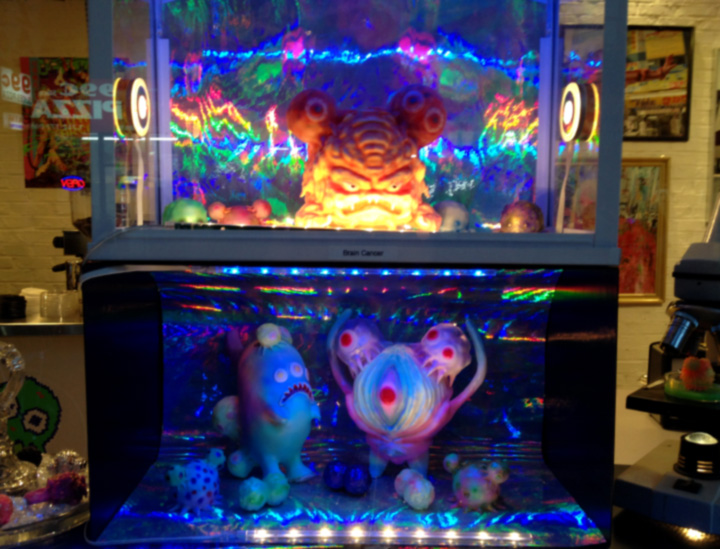
Reanimation!Underwater Zombie frog ballet!
Perhaps most striking are the photographs and videos of animatronic frog legs. Frogs commonly used for dissection are presented in a tank embedded with actuators to make the frog legs dance to the rhythm of music.
Reanimation!Underwater Zombie frog ballet! from LuYang.
Lu Yang’s work is provocative as she investigates the nature of the body and the union between human-made technology and the natural world. My one critique is that in some work the anime aesthetic overwhelms the work itself so that the content is muted by the language of anime.
On Transmitting Ideology at El Museo del Barrio

On Transmitting Ideology
11 radio guns from “On Transmitting Ideology” will be on view as part of the exhibition “PLAYING WITH FIRE: Political Interventions, Dissident Acts, and Mischievous Actions” curated by Nicolás Dumit Estévez at El Museo del Barrio from September 6, 2014 – January 3, 2015.
The installation presents eleven wooden guns outfitted with radios broadcasting declarations on freedom and transformation in our society. The broadcast is an audio montage composed from snippets and portions of speeches by Calvin Coolidge, Reagan, Obama, MLK, Enoch Powell, Malcolm X, MacArthur, George Wallace (former governor of Alabama), Barry Goldwater, William F. Buckley and Noam Chomsky – speeches that have helped define contemporary conservative vs liberal ideology. The audio montage is available online: http://ambriente.com/ideology/
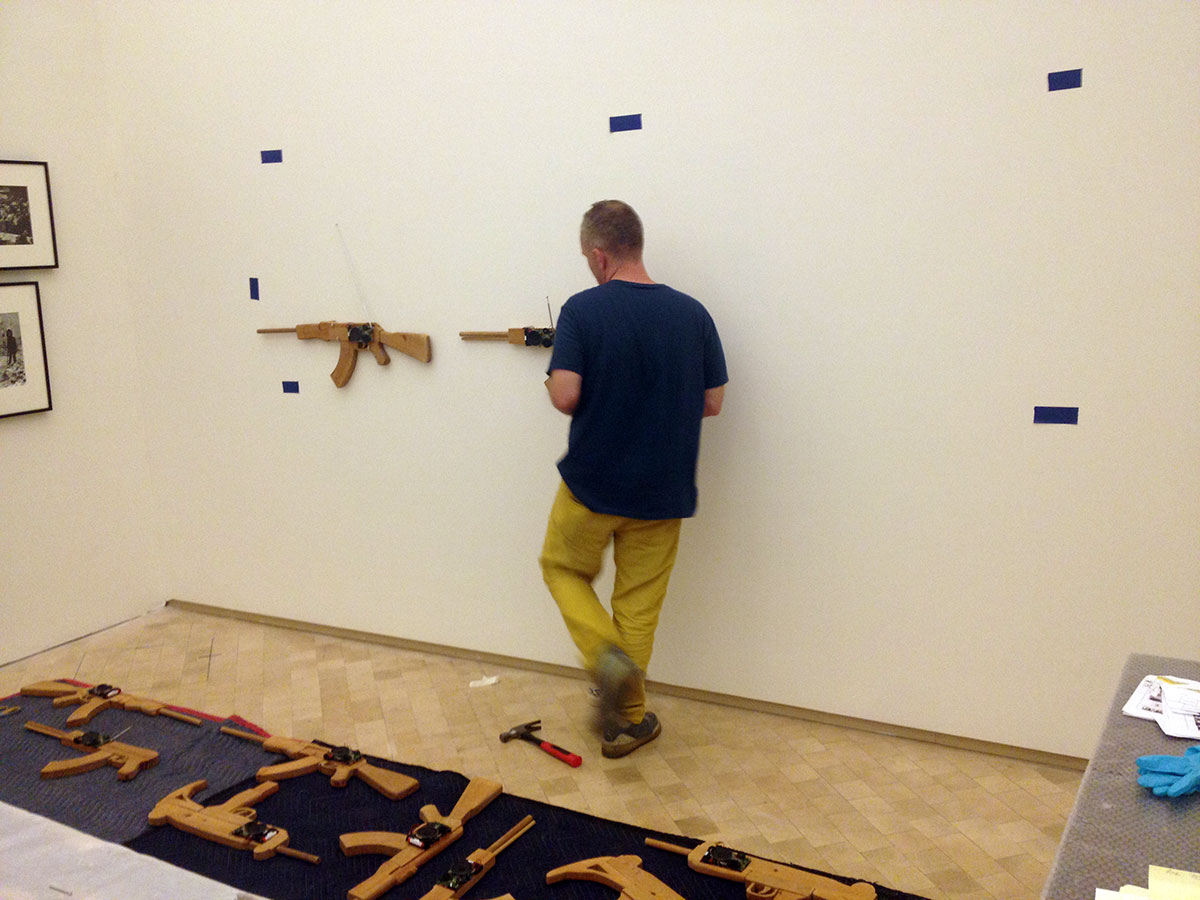
Installing “On Transmitting Ideology” at El Museo’s Carmen Ana Unanue gallery, September 3rd, 2014
“Vagaries of the Commons” at Artspace, New Haven, CT

EXCESS NYC at Artspace in New Haven, CT
“Vagaries of the Commons,” curated by Sarah Fritchey, will be on view July 25 through September 13. Brooke and I are participating in a group show revolving around the concept of the “commons” in today’s increasingly privatized public spaces. The curated artists are cultural producers that interact with the gray zones of private vs public to investigate various social issues.
Our food collection and compost bike for the ongoing project EXCESS NYC is on exhibit and on Saturday, September 13th, we will be collecting food and having a picnic as part of that day’s closing events.
Here’s the full description or go to the Artspace site that also includes links to the artists.
Artists and contributors include: Brad Armstrong, Ricardo Miranda and Brooke Singer; Lani Asuncion and Gary Aronsen; Mengyu Chen; The Elm City Dance Collective; Jason Friedes; Focus Lessness (Michael Romano and Milton Laüfer), Occupy New Haven; Phil Lique; Project Storefronts; Scott Shuldt; and Under 91 Project.
The concept of “the commons” predates the feudal era in early Germanic and Roman settlements, where communal land ownership prevailed. Originally, the concept referred to the public’s interest and right to access essential natural resources that are held in common and not owned privately, including land, water, animals and fish. Gradually, as royalty and then a central government gained power, the notion of communal land ownership disappeared and the concept of “the commons” evolved.
In 2014, this concept is increasingly complex. Legislation pertaining to the regulation and privatization of common space responds to changes in government, the economy, the sciences and our natural surroundings. Also, the concept of the commons extends far into the charted and uncharted vacuums of the digital realm.
This exhibition presents a group of artists, based in and around greater New Haven, who make works that operate within the penumbras and cracks of the legal systems that oversee its “commons”. These grey zones are the flexible and the often vague environments from which the show’s title takes its inspiration
The show identifies four specific sectors and human rights questions addressed by artists practicing in and around New Haven. These include: the material commons (who has the right to order the build and name structures, homes, cities, maps?), the knowledge commons (who has access higher education, public libraries, the internet?), the aesthetic commons (who has the right to define and control image production?) and the affective commons (how are emotions policed and kept public/private?). The essential question that each work asks is: who has the right to have a voice?
The exhibition is organized to mindfully accompany Laureline Kruse’s Mobile Museum Student Apprenticeship Program project, which will share an exhibition space with the show.
Latino Artists at the Guggenheim
The Guggenheim presents a strong selection of Latino artists (as problematic as the label is), however, the work that is featured is not amongst the strongest by these individuals. Three works that stood out are Carlos Amorales’s Calder-inspired cymbal mobile that visitors may play, Jonathas de Andrade’s “Posters for the Museum of the Northeast Man. 2013”, and Juan Downey’s Amazonian film installation. Many of the works are presented out of context as many were performative and/or protests, works in which the power lies in the environment and moment when they were executed. Presented within the context of the museum robs the cultural significance of many of these pieces.
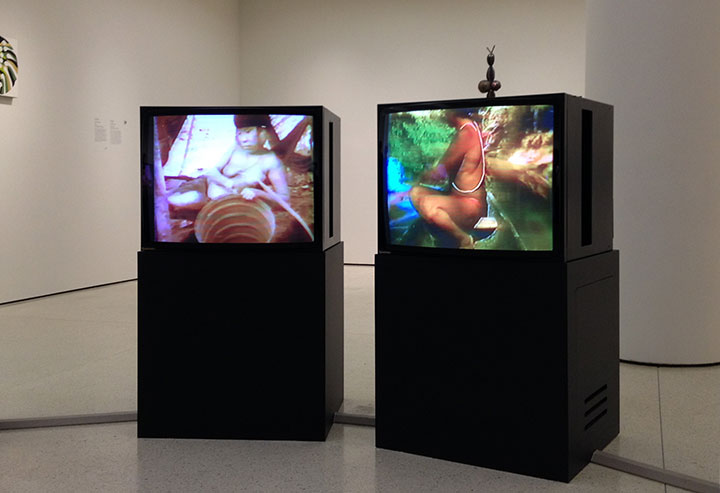
Juan Downey
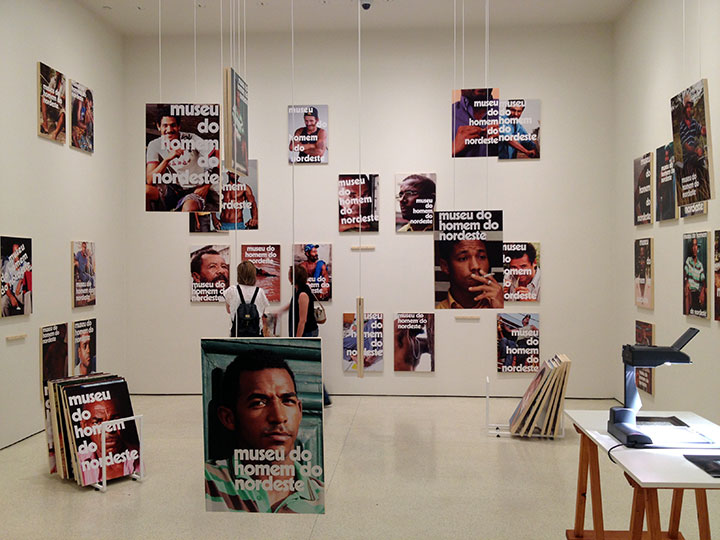
Jonathas de Andrade
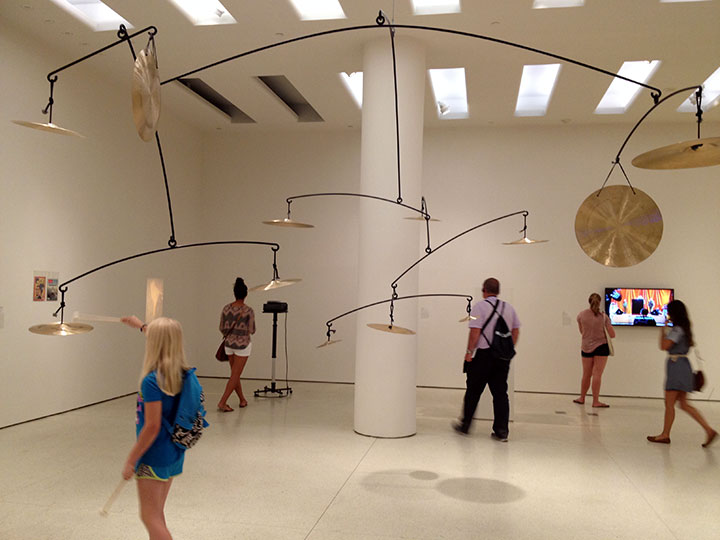
Carlos Amorales
In Production – “Mediated Idols”
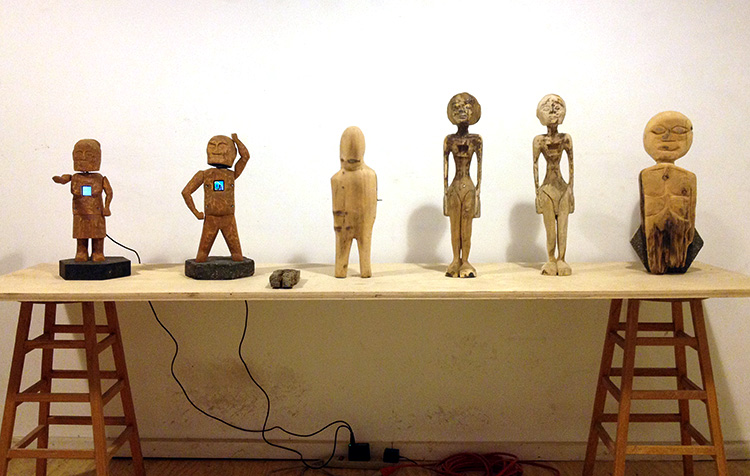
Mediated Idols – work in progress
Yesterday, I had a studio visit with folks from Museo del Barrio which gave me an opportunity to assemble current work and talk about it. My focus over the last few months has been a combination of hand-drawn animations and wooden sculptures which will come together in a new media sculpture series titled “Mediated Idols.”
About “Mediated Idols”
The editors of DE-WESTERNIZING MEDIA STUDIES, Curran and Park ask the following questions in the book’s introduction:
1. How do the media relate to the power structure of society?
2. What influences the media and where does control over the media lie?
3. How has the media influenced society?
4. What effect has media and new media had on the media system and society?
In considering these questions, my initial response is cannibalization. Historically, the cannibalization of one civilization by an emerging civilization. In contemporary reality, the transformation of highly mediated popular culture by either youth subcultures or ethnic specific cannibalizations that transform globalized pop culture in unexpected manners.
In creating the “Mediated Idols,” I am studying artifacts from the pre-Aztec city Teotihuacan that had far reaching influence geographically and through time. As I look at these Mesoamerican artifacts, I am as well studying contemporary popular cultural icons that fade only to reappear in new formats. “Mediated Idols” will combine the physicality of past artifacts with virtual representation and data of contemporary life. As stand alone sculptures, “Mediated Idols” will present greater attention to material and form than the “Undocumented Drones.” The animations will also have greater coherence with the sculptures.
Other images from the studio visit…
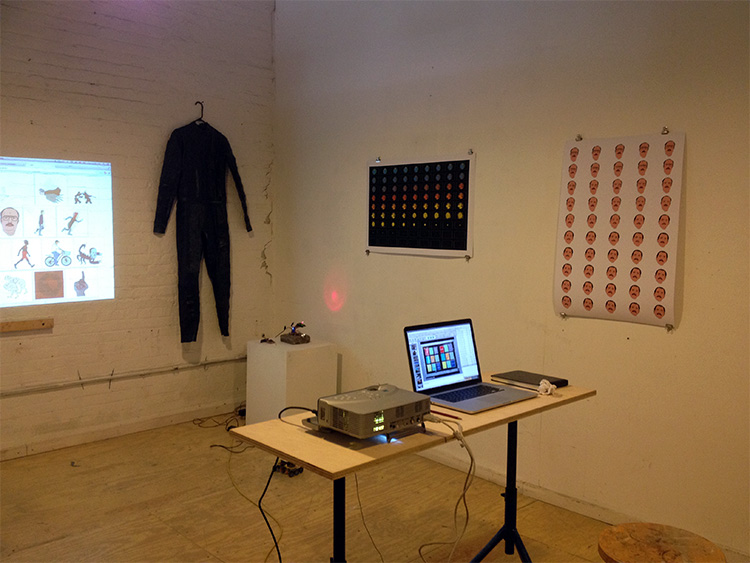
Studio Visit, June 2014
Support Feminist Installation “Rub Me the Wrong Way” by Traci Talasco
Artist Traci Talasco has maintained an active artist practice in New York City over the last 10 years and she is currently working on an installation that will be featured at the Brooklyn Arts Council.
The installation “Rub Me the Wrong Way” will transform the gallery into a home environment created entirely out of sandpaper, which will wear down as you walk through the space. The title humorously refers to the unrealistic, societal expectations placed on women to “do it all”, and how we become worn down by our absurd attempts to juggle everything.
Traci is reaching out to the public to support the realization of this installation and she’s getting very close. If you like the concept and would like to see it realized go to indiegogo to contribute financially.
Chelsea in February: Nothing Worth Seeing
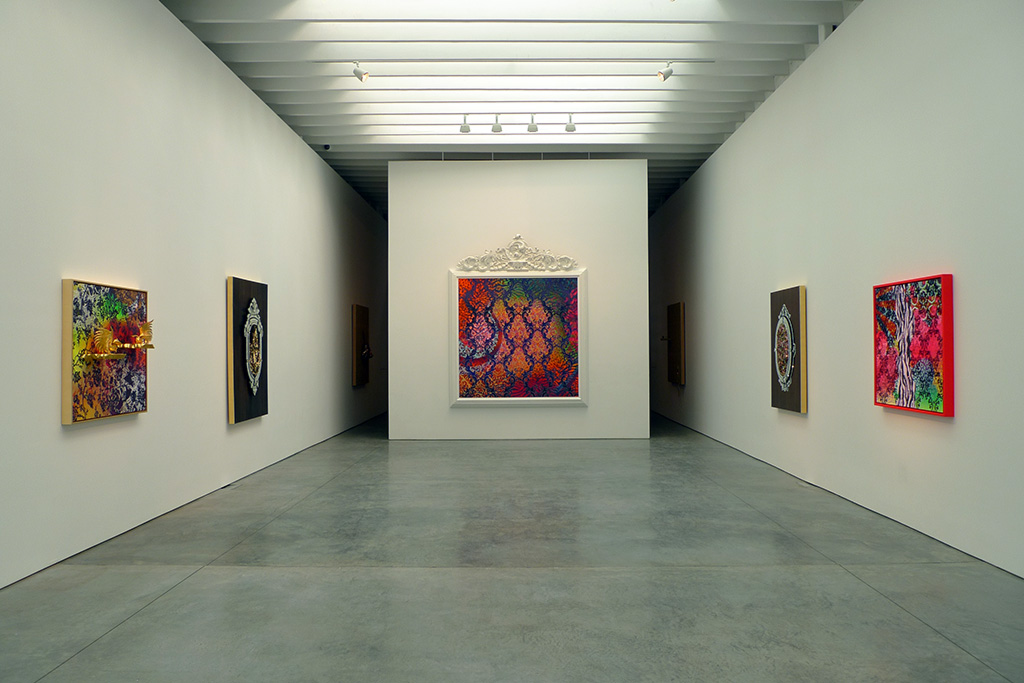
Carlos Rolon at Paul Kasmin Gallery
The title isn’t entirely true, I did step into Carlos Rolon’s show at Paul Kasmin Gallery expecting to walk out quickly, but found myself drawn in by the diversity of wall pieces. Upon first look, the work all appeared slick and uniform – nice, colorful rectangles hanging beautifully on white walls. I can’t say that I really cared for any of the wall pieces, they are gaudy and not very interesting, but I’m glad that I walked through the space to find an installation with a television playing an interview with Manos de Piedra, Roberto Duran… a figure from my childhood. The hidden installation is much more interesting than any of the wall pieces as it does a nice job of capturing a specific time and culture that many Latinos from my age group can identify with. Rolon born in 1970 recreated his childhood wood-panel basement in the installation and featured excerpts from televised moments with the boxer Roberto Duran. Unfortunately, I didn’t document the installation.
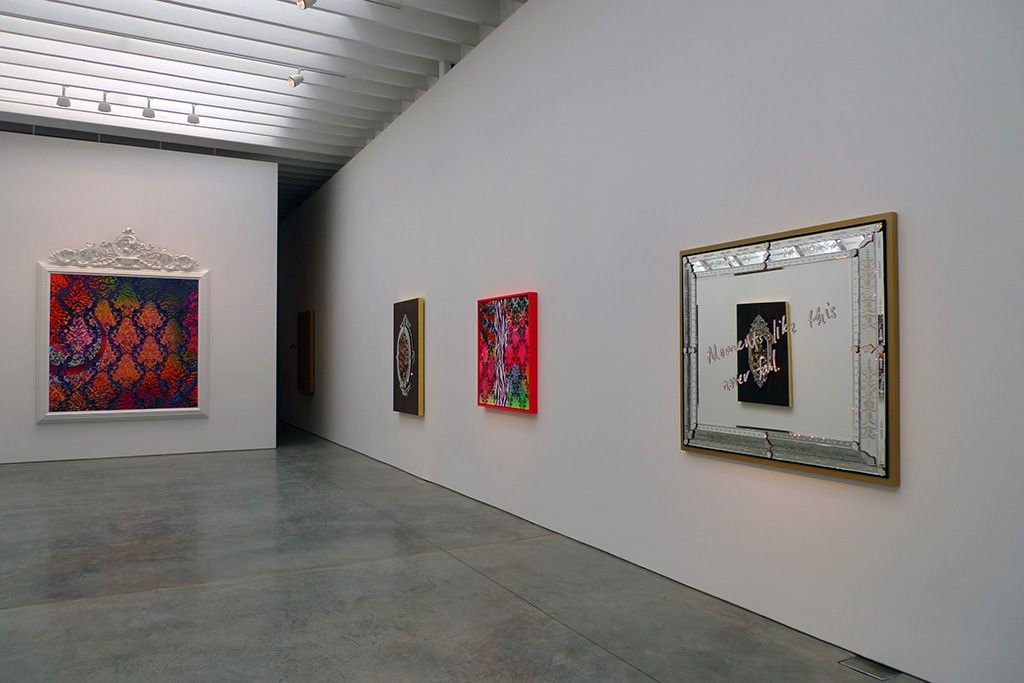
Carlos Rolon at Paul Kasmin Gallery
At Andrea Rosen, you can find David Altmejd’s crazy, obsessive, sculptures that point to animation. I’ve seen several of these over the years and once you’ve seen one, there’s not much of a need to see another. They are intricate and obsessively done, but not very interesting. I was much more intrigued by the face sculpture below than the complex, multilayered room scale plexi and mixed media sculptures.
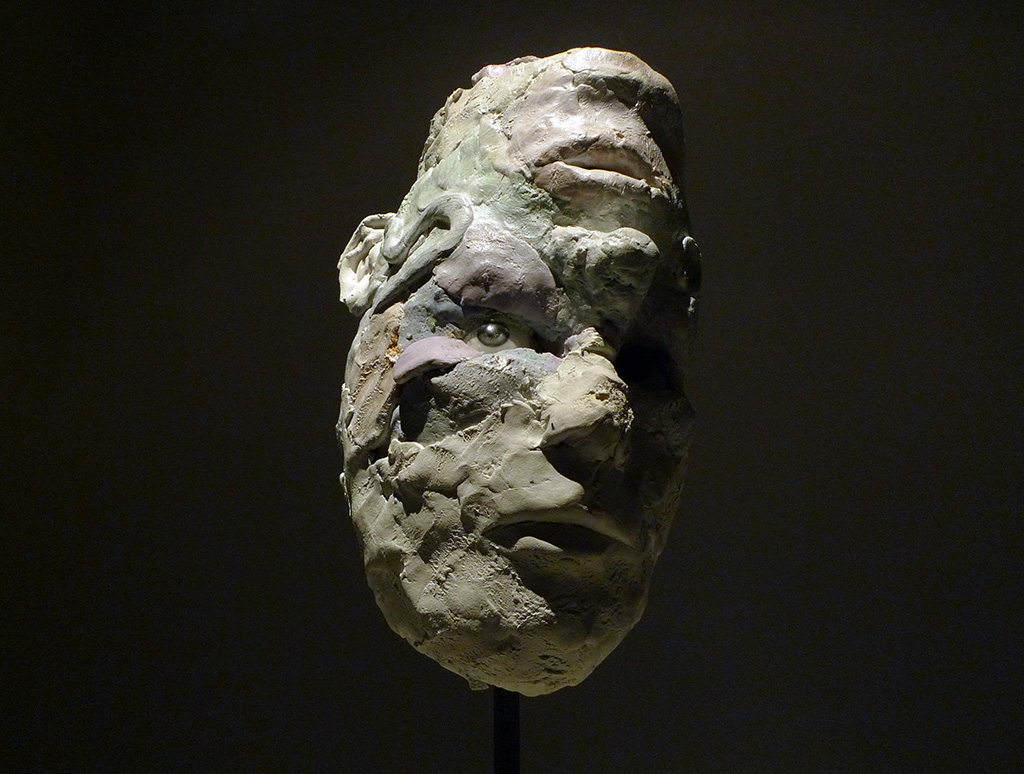
David Altmejd
Jiha Moon’s work at Ryan Lee isn’t very interesting or worth a visit either, but I loved the graphic comic accents in the paintings and the combination of seemingly traditional ceramics with pop culture. On the surface, the work is whimsical and fun, but doesn’t do much more, beyond appearance.
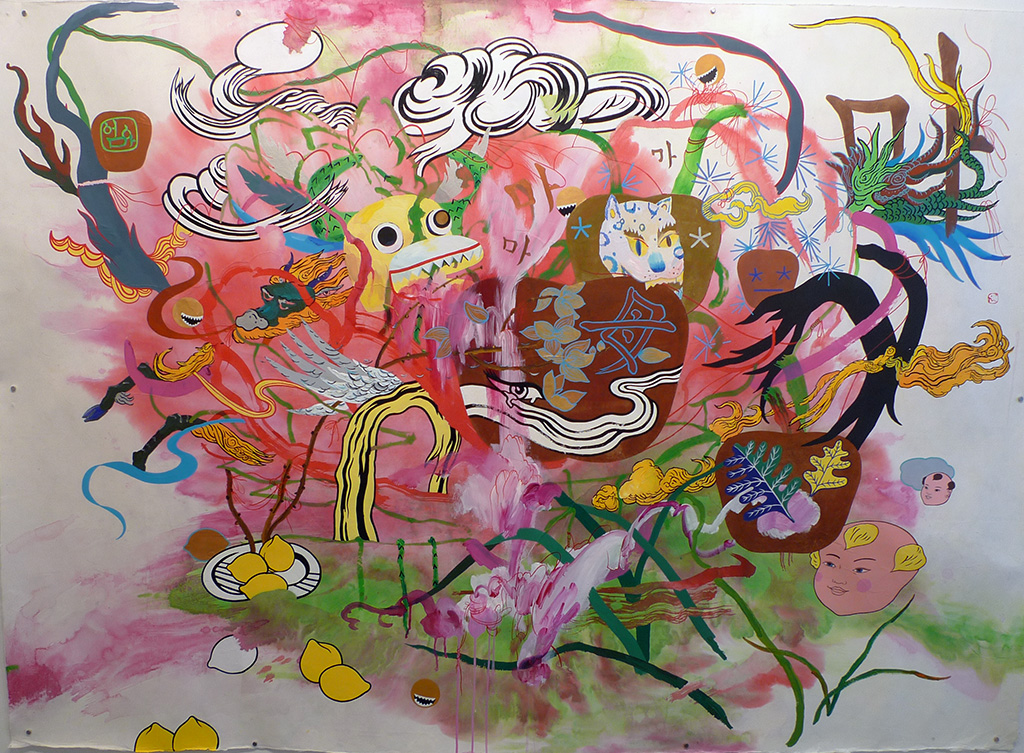
Jiha Moon
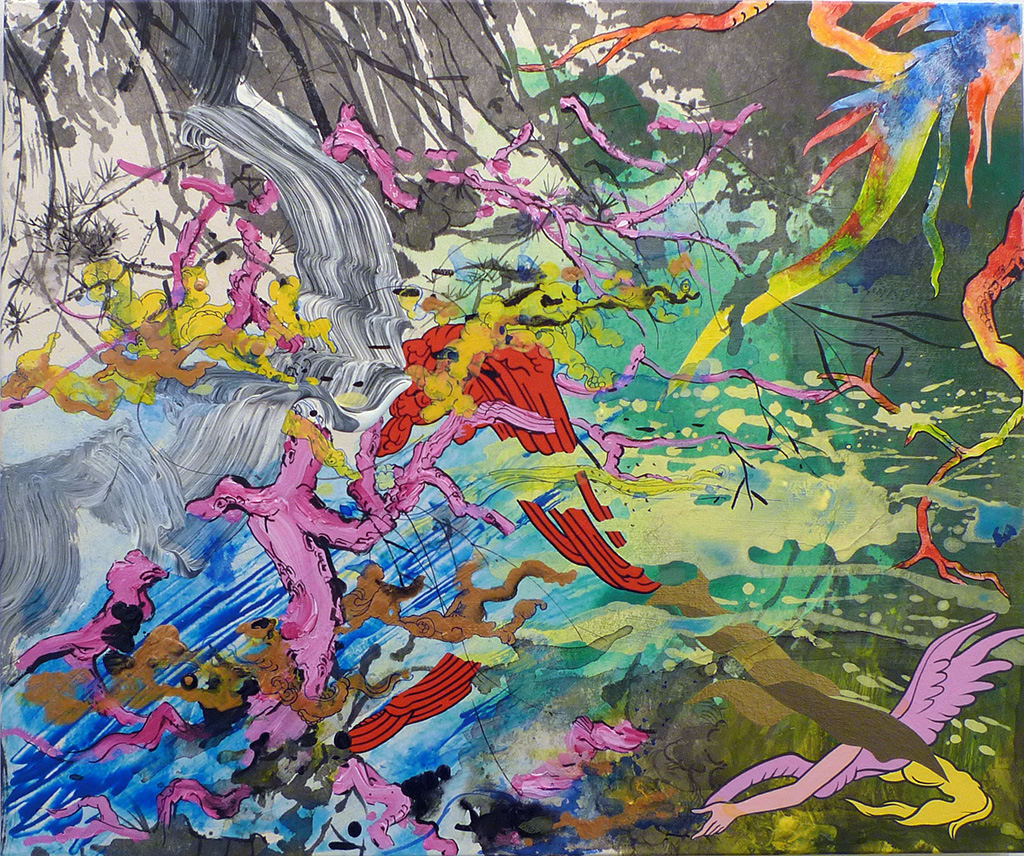
Jiha Moon
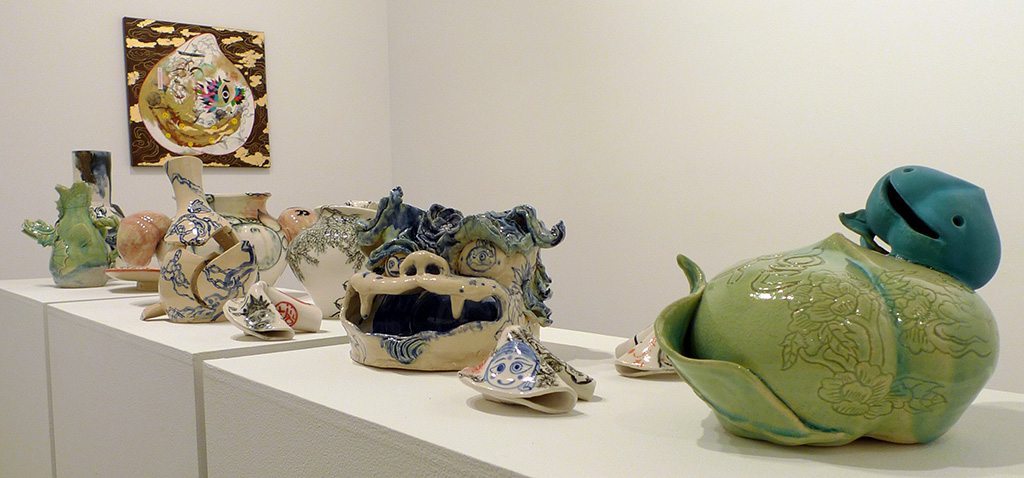
Jiha Moon
Keith Sonnier’s work at Pace are engaging, but again they leave a bit of an empty feeling… more decorative than anything.
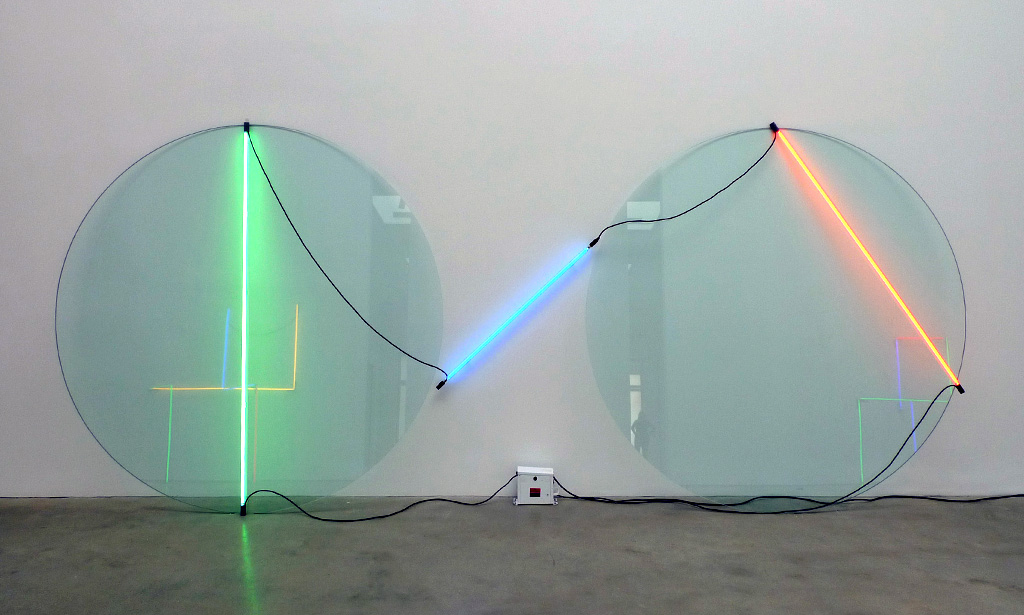
Keith Sonnier
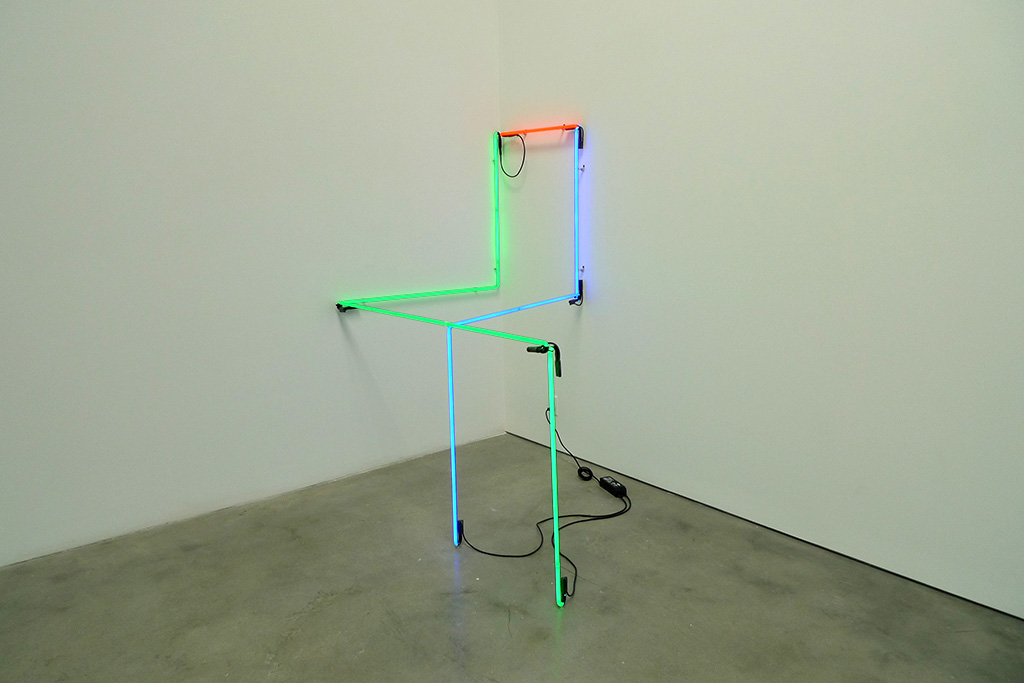
Keith Sonnier
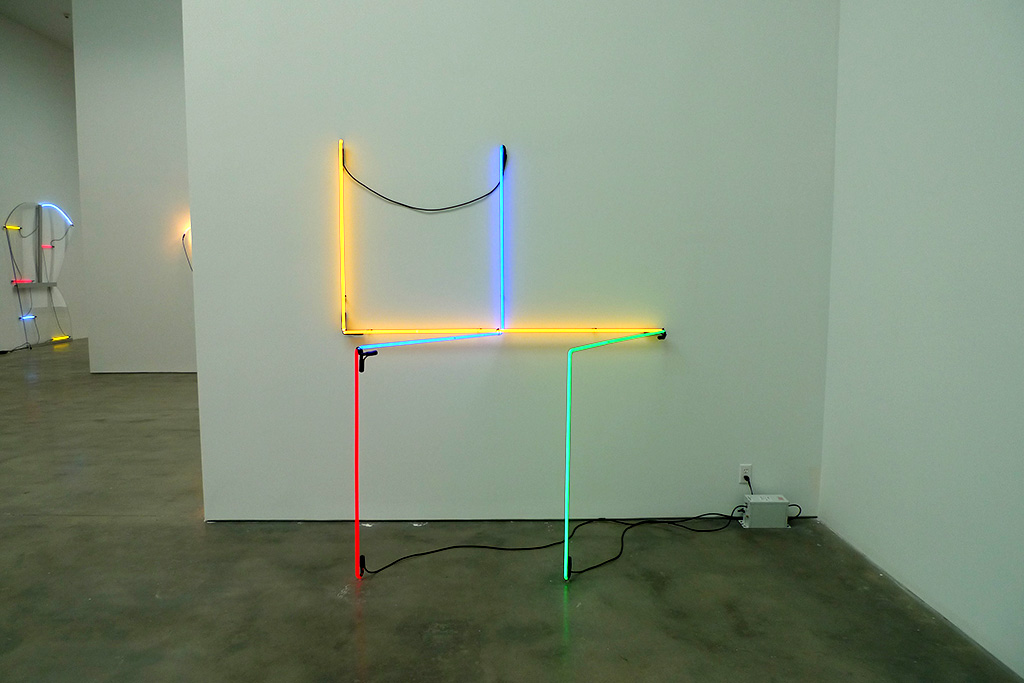
Keith Sonnier
I don’t have anything to say about Andy Denzler paintings other than they made me long for Richter Gerhard… Though uninteresting, stylistically, I felt the need to take one photograph.
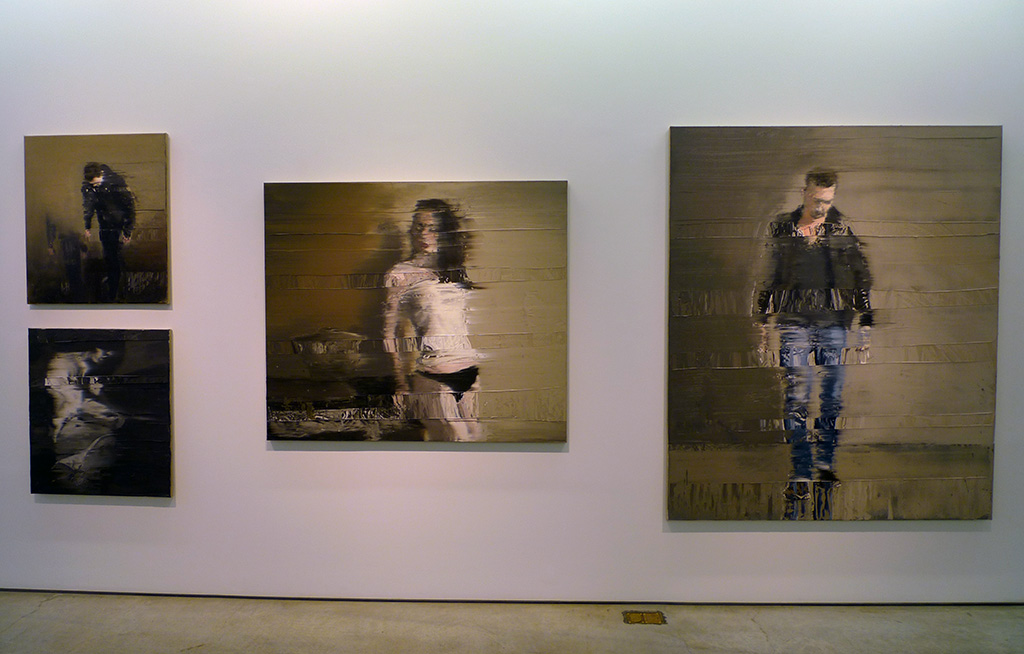
Andy Denzler
Ralf Schmerberg nice colorful prints of random things he encounters are kind of interesting. I like the title of the show “Greetings from our planet.”
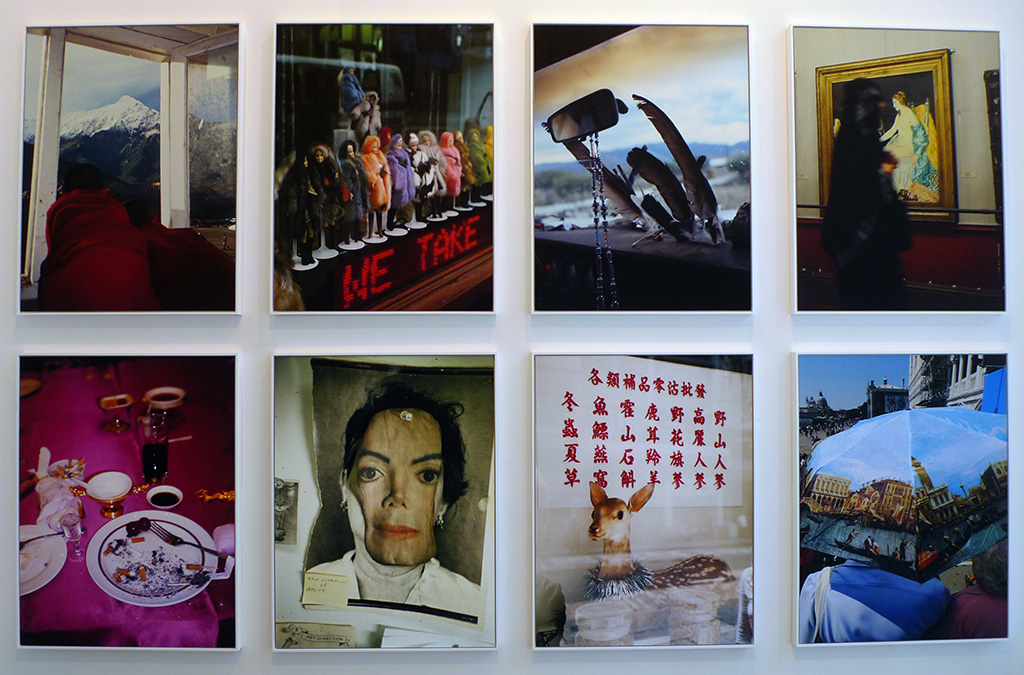
Ralf Schmerberg
Perhaps the high light of the stroll through Chelsea was the John Ahearn sculptures at Alexander and Bonin. But once again, I came away feeling a bit empty as I’ve experienced Ahearn’s work on the street where it belongs and it’s much more powerful than in a gallery.
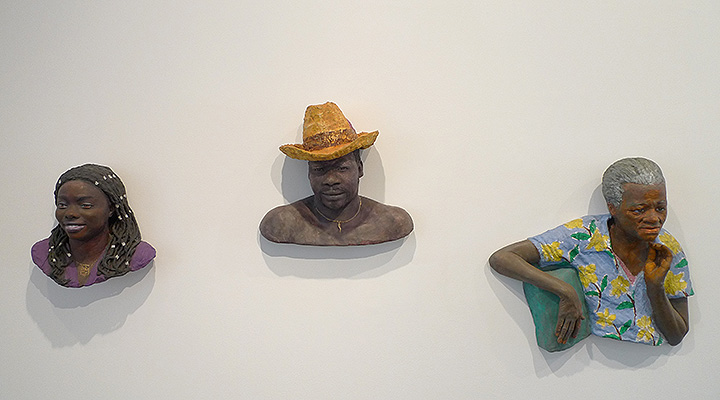
John Ahearn
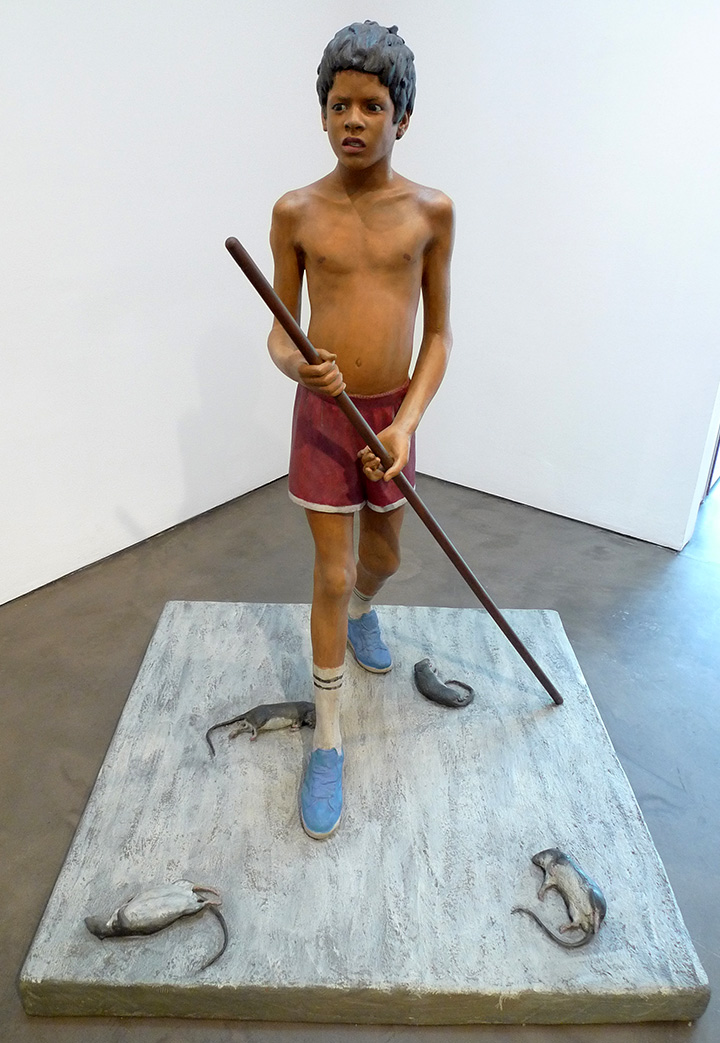
John Ahearn
Nearly every time, I do a Chelsea Gallery walk, I find something redeeming, worth seeing, but this February, I unfortunately did not come across anything interesting. And to top it off, the fashion people due to Fashion Week made the walk really annoying. And sadly, on the way to the subway, I came across this horrific scene where an MTA driver lost his life.
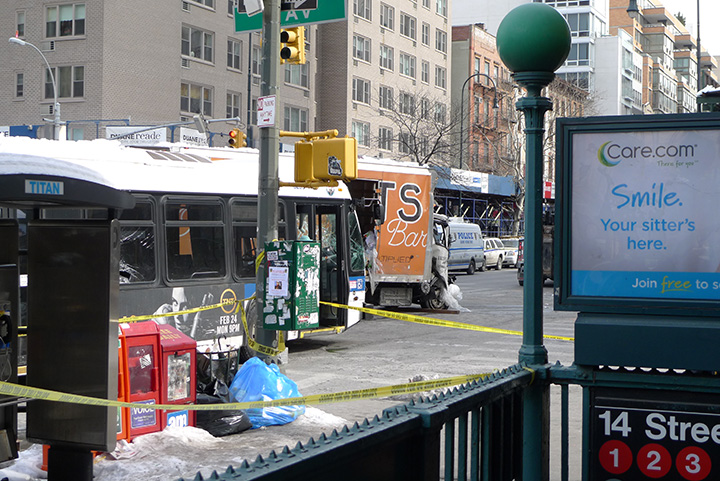
Bus Crash, 12 February, 2014, NYC
Duke Riley at MagnanMetz Gallery
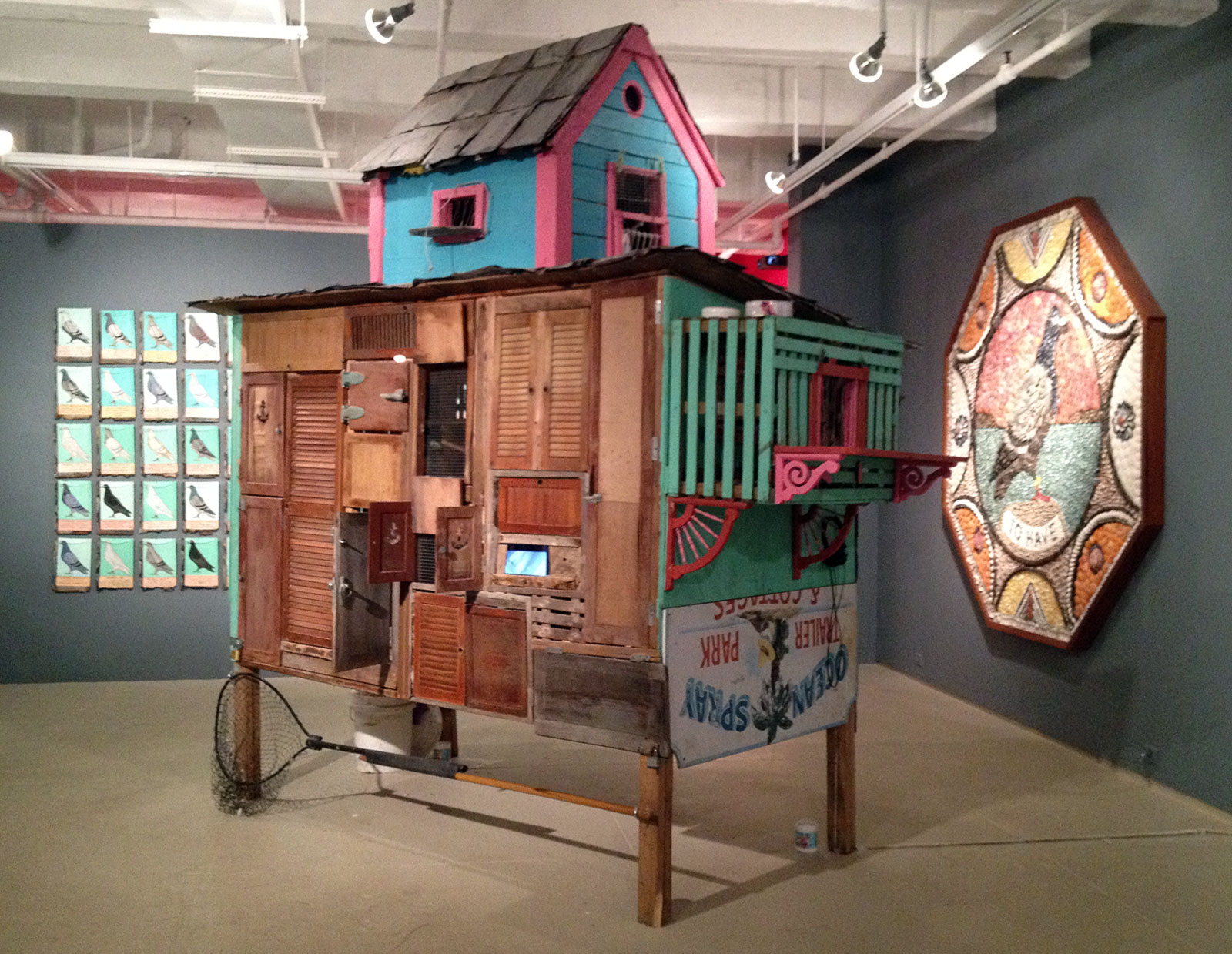
Duke Riley’s Pigeon Coop was in use at the Florida Keys before gallery installation
Artist Duke Riley is a pigeon guy and for his recent project, he worked as a pigeon trainer in the Florida Keys. As the New York Times Article “Avian Artistry, With Smuggled Cigars” states “He started the training in Florida last year with 50 pigeons; 23 went on the first mission, this summer. Only 11 returned.” (The NY Times video is well worth watching.) The mission for the pigeons was a small political intervention… they served as documentarians or Cuban Cohiba cigar smugglers. Some of the pigeons carried small cameras that captured their travel between the Florida Keys and Cuba others travelled from Florida with empty harnesses to return with cigars.
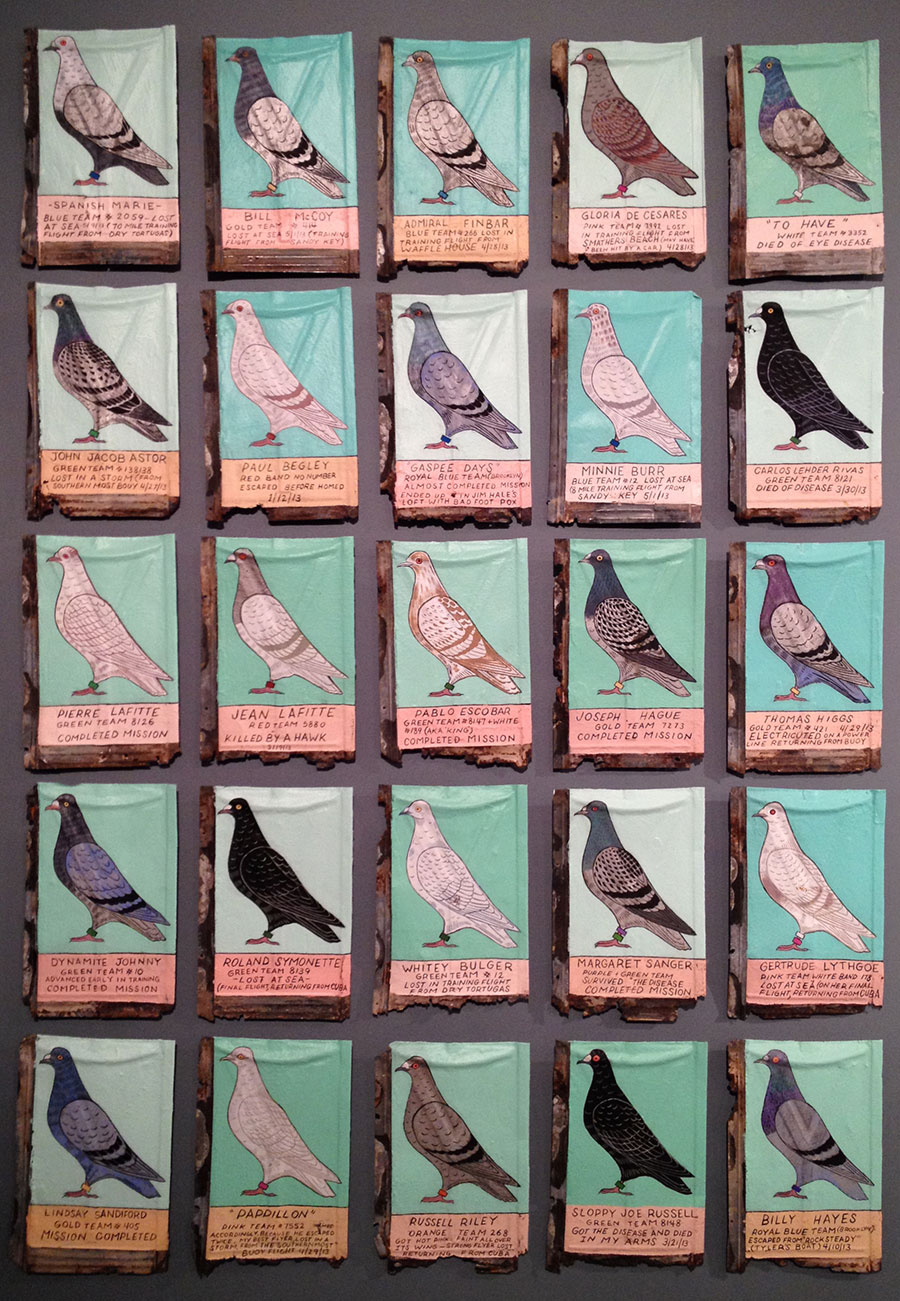
Pigeon paintings by Duke Riley
The pigeon project’s artifacts are installed in the first gallery of MegnanMetz until 25 of January 2014, where you can see the pigeon coop with the pigeons still living in it, pigeon paintings, pigeon mosaics made from sea shells and videos that the pigeons made as well as other artifacts.
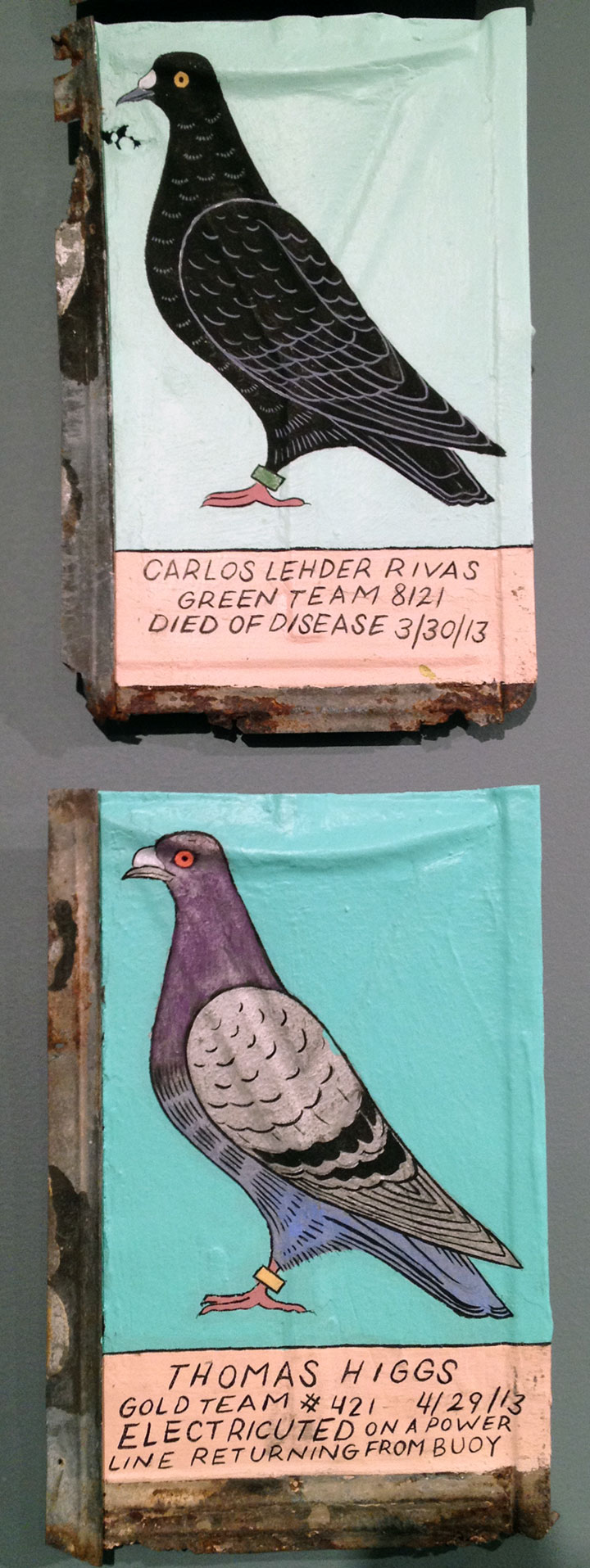
Pigeon paintings by Duke Riley
The second gallery presents documentation of a collaborative performance along the canals of Zhujiajiao in China that re-stages a legendary race of the Chinese zodiac. A projected wall video shows the race and along another wall are mounted animal masks that performers wore to represent the various creatures of the Chinese zodiac. On the wall opposite from the video is a large scale drawing capturing the legend of the Chinese zodiac.
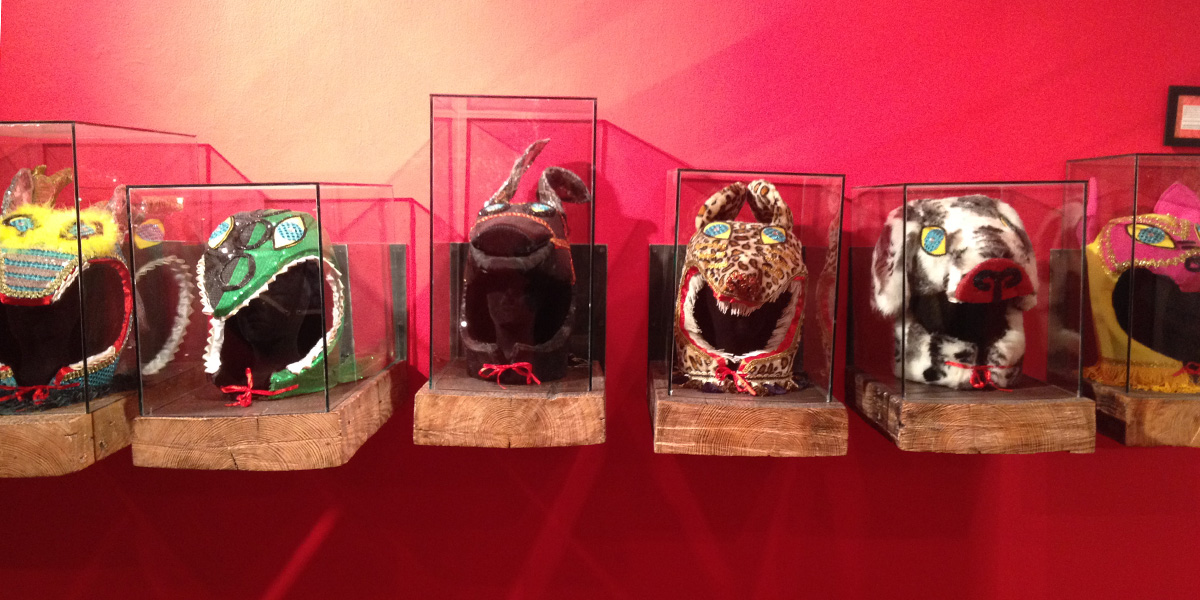
Duke Riley’s masks from the Chinese zodiac
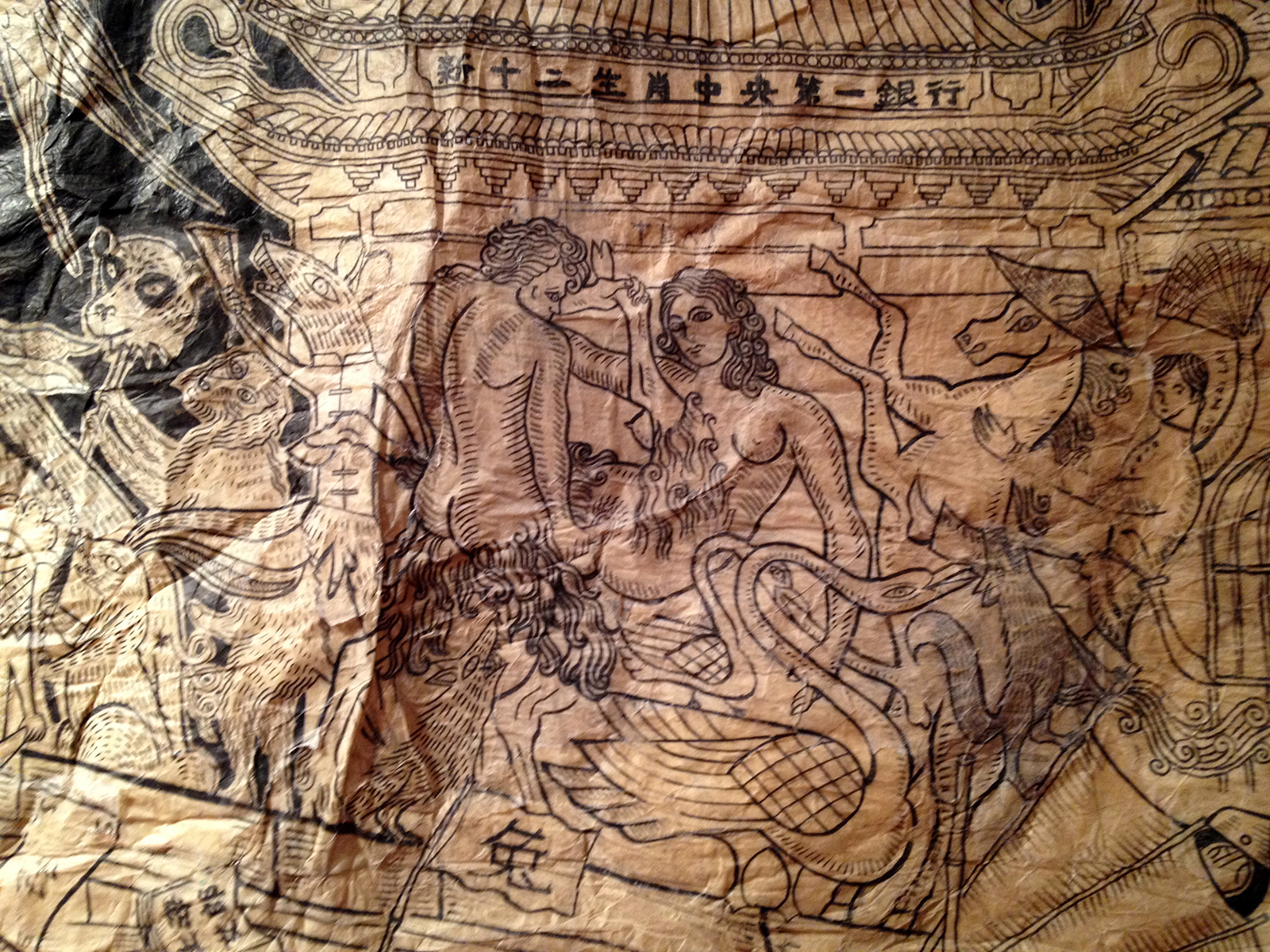
Chinese zodiac by Duke Riley
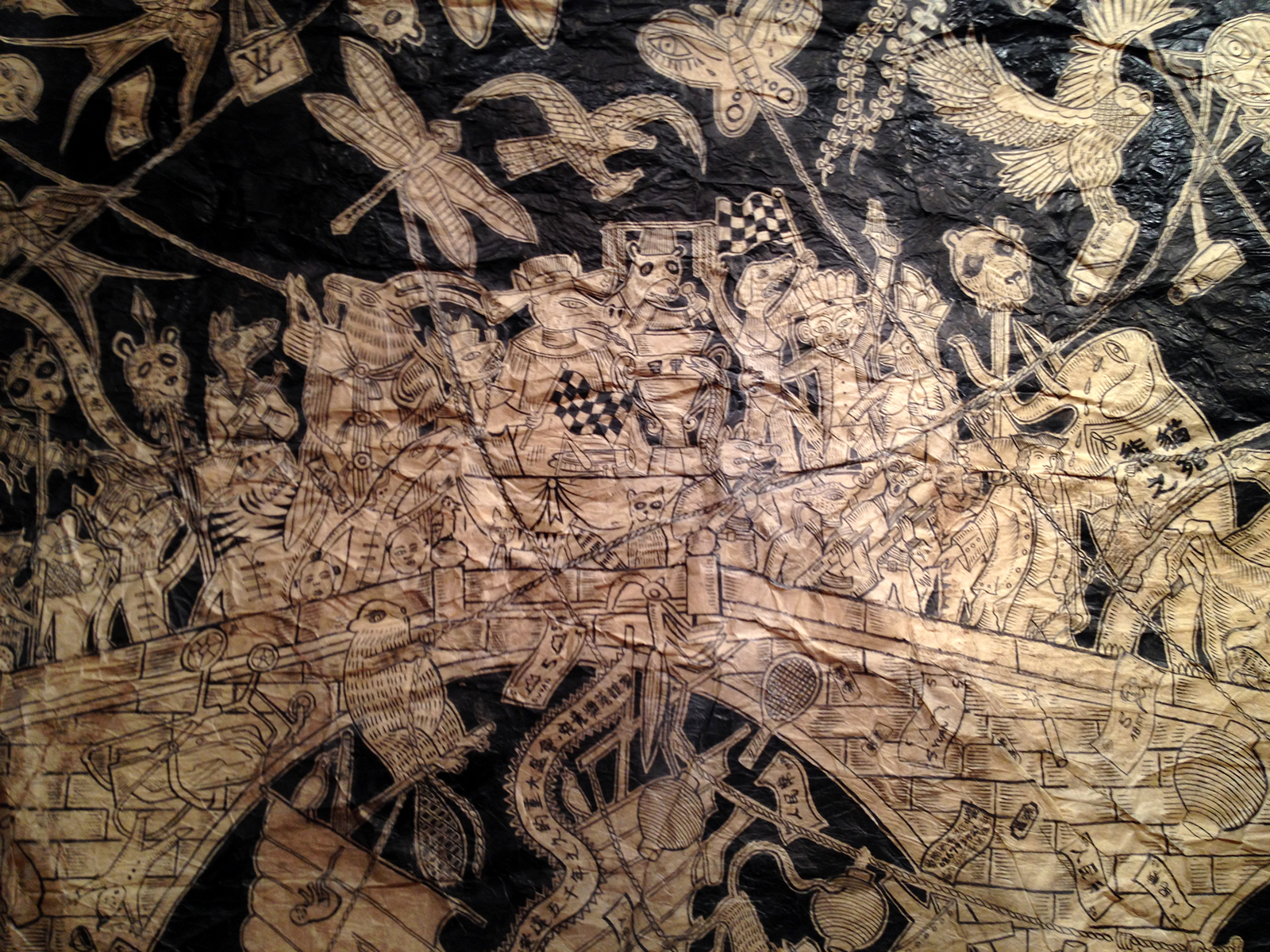
Chinese zodiac by Duke Riley
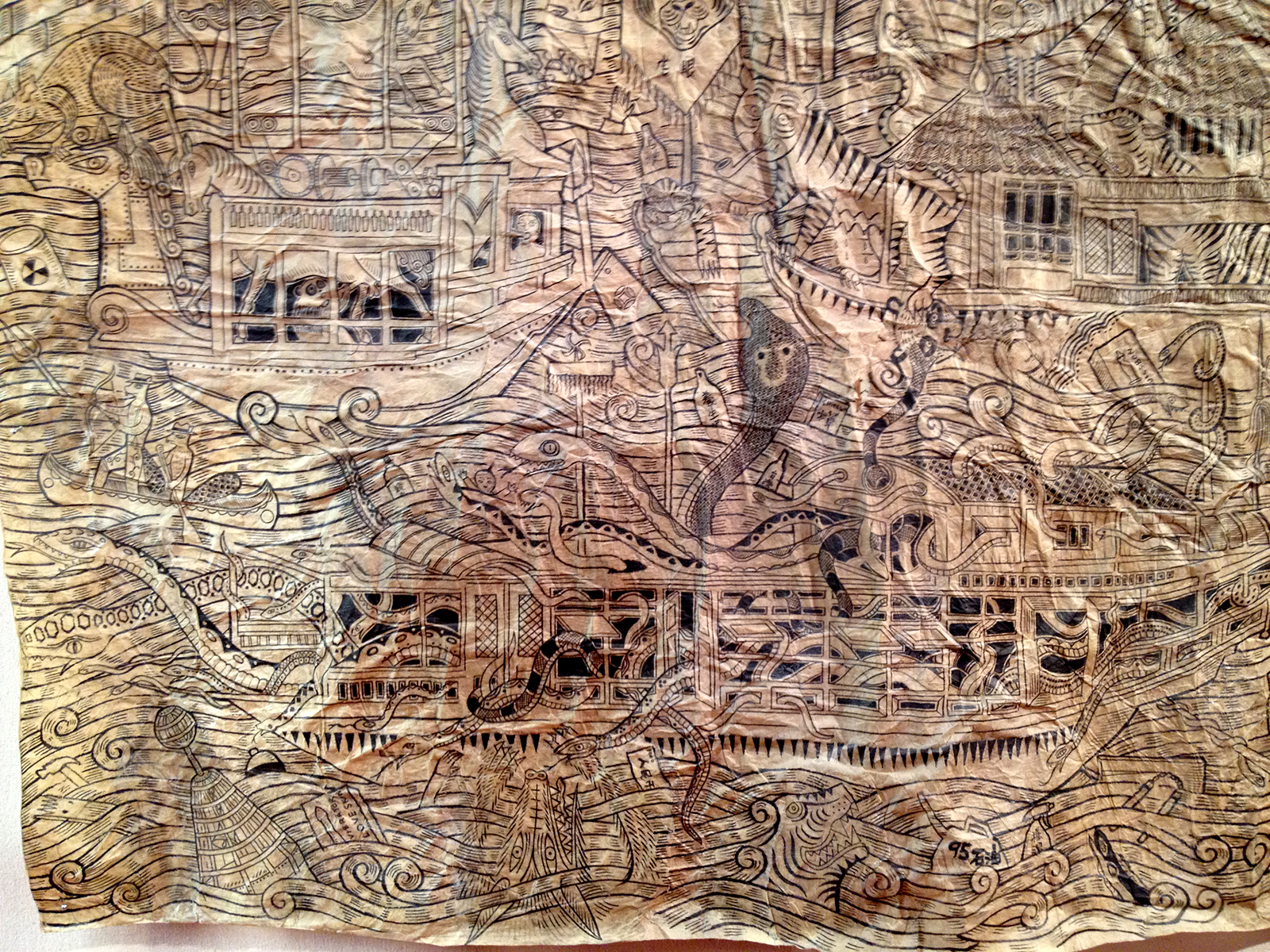
Chinese zodiac by Duke Riley
Alex Prager at Lehmann Maupin
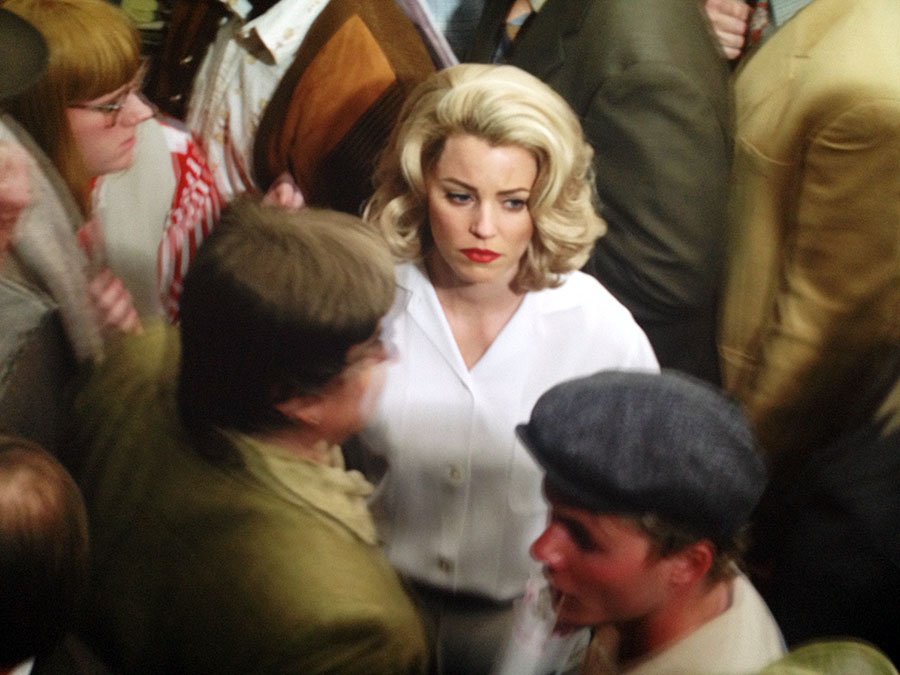
Alex Prager at Lehmann Maupin
Alex Prager employed a soundstage in Hollywood to create her latest set of works. Near the street entrance hang beautiful large scale color photographs and toward the back is an immersive three-channel video installation that the prints appear to be taken from. As the press release describes the video installation
the film opens with a series of confessional monologues in which characters from the crowd scenes poignantly relate their own stories and insights, such as childhood memories, recurring nightmares and personal revelations. Suddenly, the scene changes and an orchestra strikes as a sea of people flood into view. The iconic heroine then leads the viewer on a journey through the crowd wordlessly expressing a range of emotions including isolation, sadness, confusion, curiosity and anxiety. The juxtaposition of character monologues and the frenetic crowd scene poignantly illustrates that within a swirling sea of strangers, there are countless individual stories and unique experiences unfolding.
The concept is striking and the video could easily be longer by portraying more individuals in the beginning portion. In fact the small number of portraits at the beginning undermines the concept. I believe that commonly, individuals living in dense urban environments desire to peak into the lives of others. That is to have the opportunity to observe the day to day lives of ones neighbors or the person sitting across one in the subway. This has been a common motif in films as characters use binoculars or telescope to spy on the neighbors.
The power of bird’s eye view of a multitude of individuals flowing in a public space that is presented in the video would be enhanced if the viewer begins to identify individuals from the portraits.
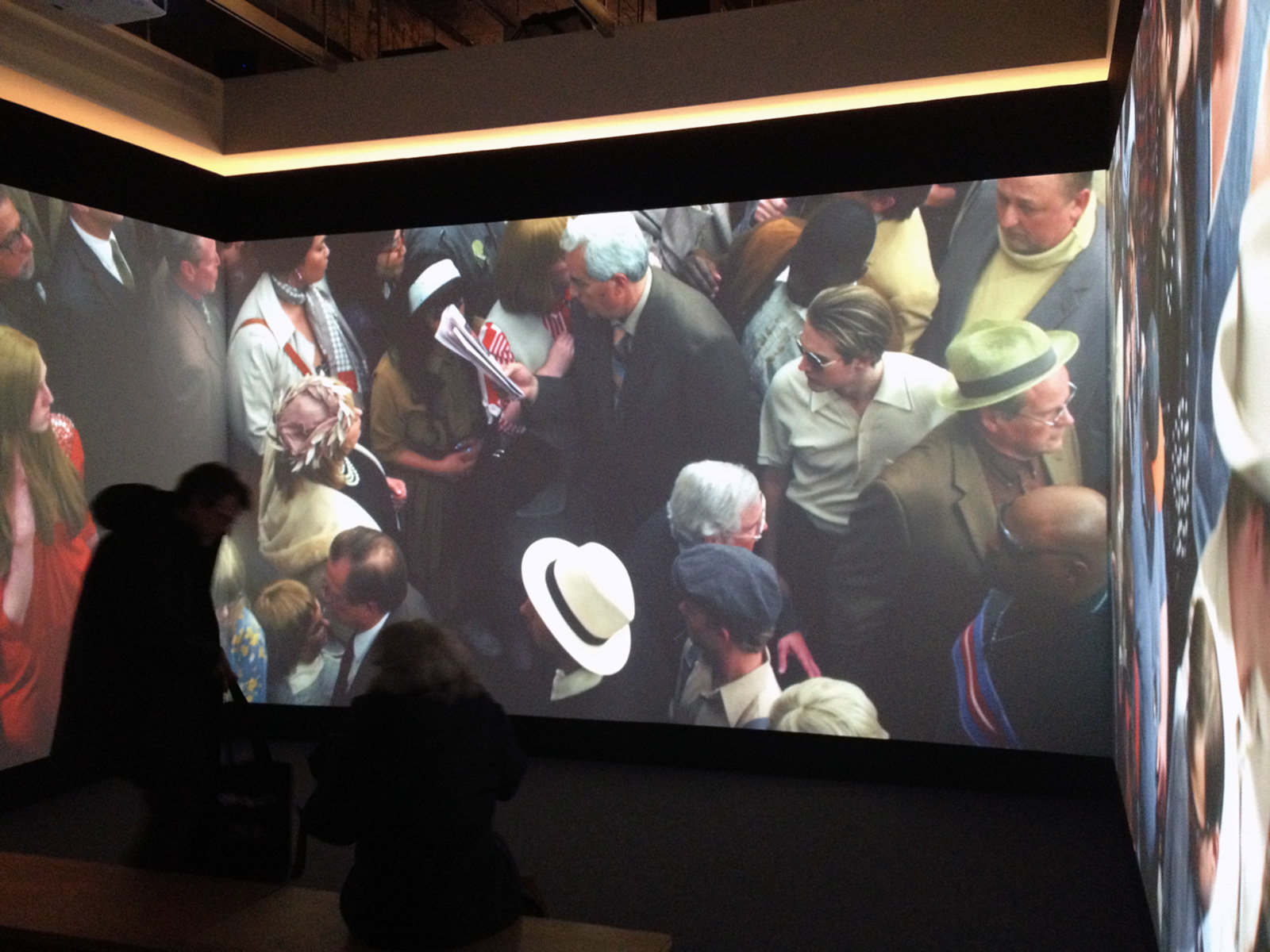
Alex Prager at Lehmann Maupin
One other element that I’m critical off is the need to stylize the individuals in the video. The people in portraits were highly made up to the extent that they seem to represent stereotypes. This exaggeration reduces the gravitas that the work may otherwise carry. Perhaps by evoking stereotypes, the artist is reflecting on how mediated our lives are or that our lives are but a fiction.
